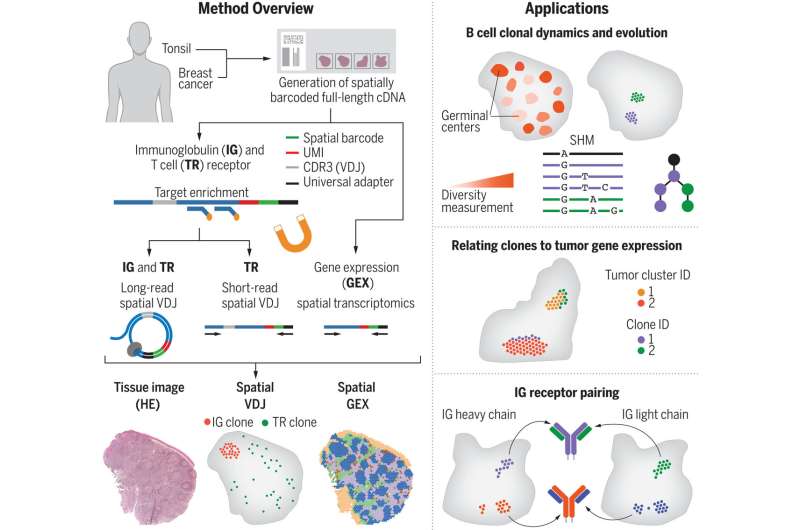This article has been reviewed according to Science X's editorial process and policies. Editors have highlighted the following attributes while ensuring the content's credibility:
fact-checked
peer-reviewed publication
trusted source
proofread
New method is better able to map immune response and paves way for new treatments

A new method, developed at Karolinska Institutet, KTH Royal Institute of Technology and SciLifeLab in Sweden, can identify unique immune cell receptors and their location in tissue, a study published in the journal Science reports. The researchers predict that the method will improve the ability to identify which immune cells contribute to disease processes and open up opportunities to develop novel therapies for numerous diseases.
Immune cells such as T and B cells are central to the body's defense against both infections and tumors. Both types of immune cells express unique receptors that specifically recognize different parts of unwanted and foreign elements, such as bacteria, viruses and tumors. Each immune cell and its progeny has its own specific receptors, and in each human body there are billions of different immune cells with unique receptors.
Researchers at Karolinska Institutet, KTH Royal Institute of Technology and SciLifeLab have now developed a method that is able to both identify the different B and T cell receptors and reveal their location in human tissue.
Many areas of application
"Since activated immune cells are often found close to the targets that they attack, we want to be able to map the cells that are indeed closest to a tumor or infection," says Camilla Engblom, assistant professor at the Department of Medicine (Solna), Karolinska Institutet and one of the study's three lead authors along with Kim Thrane, KTH/SciLifeLab, and Qirong Lin, Karolinska Institutet.
"It hasn't been possible to identify both B and T cell receptors in their microenvironments using previous methods."
According to Dr. Engblom, there is a wide range of areas in which the new technique can be put to clinical use in the future.
"In cancer, the method can identify T cells that potentially attack the tumor," she says.
"They could then be used as cell therapy against cancer. We can also identify unique receptors on the B cells that are released as antibodies in specific areas of the tumor. These antibodies can be produced in the lab with relative ease and eventually give rise to novel therapies. Another field is autoimmune diseases, where the immune system attacks healthy tissue. The new technique could be used to identify the immune cells that do this and increase the chances of finding exactly what it is they attack."
An important step forward
Jeff Mold, one of the principal investigators of the study and researcher at the Department of Cell and Molecular Biology at Karolinska Institutet, sees the new method as an important step forward.
"Identifying these unique immune receptors is like trying to find a needle in a haystack, especially when it comes to autoimmune diseases," he says. "With most current methods, you destroy the tissue, which means not only that you get different immune cells mixed up but also that some cells die in the process. With this method, we preserve the cells where they are, and we can see cells that would otherwise have been lost."
Dr. Mold believes that the ability to identify B cells is arguably the main benefit of this new method.
"T cells have been a popular research target, while the B cells have been a little overlooked, especially in cancer," he says. "But now we can track how B cells develop and expand directly in tissue."
More information: Camilla Engblom et al, Spatial transcriptomics of B cell and T cell receptors reveals lymphocyte clonal dynamics, Science (2023). DOI: 10.1126/science.adf8486. www.science.org/doi/10.1126/science.adf8486


















